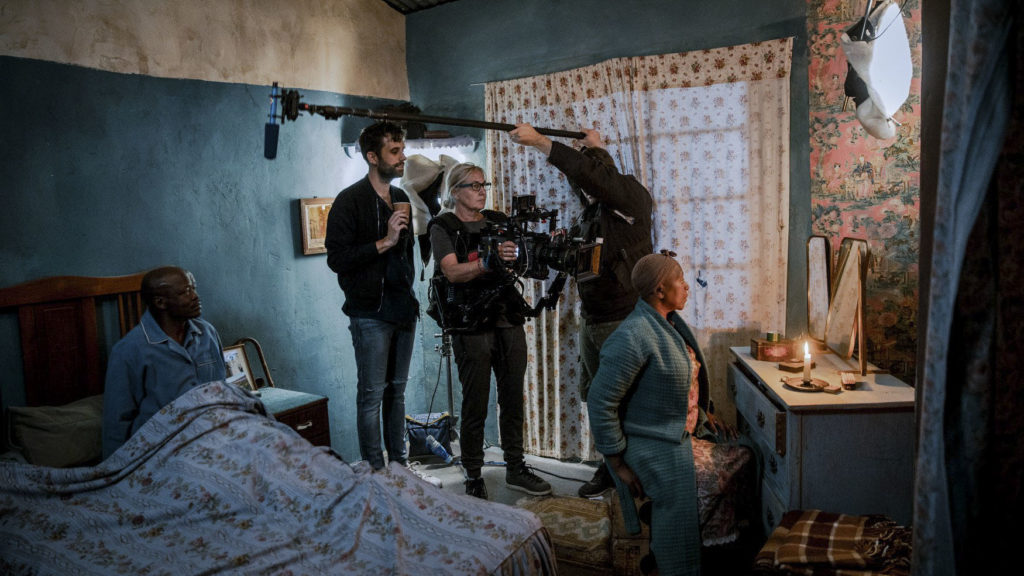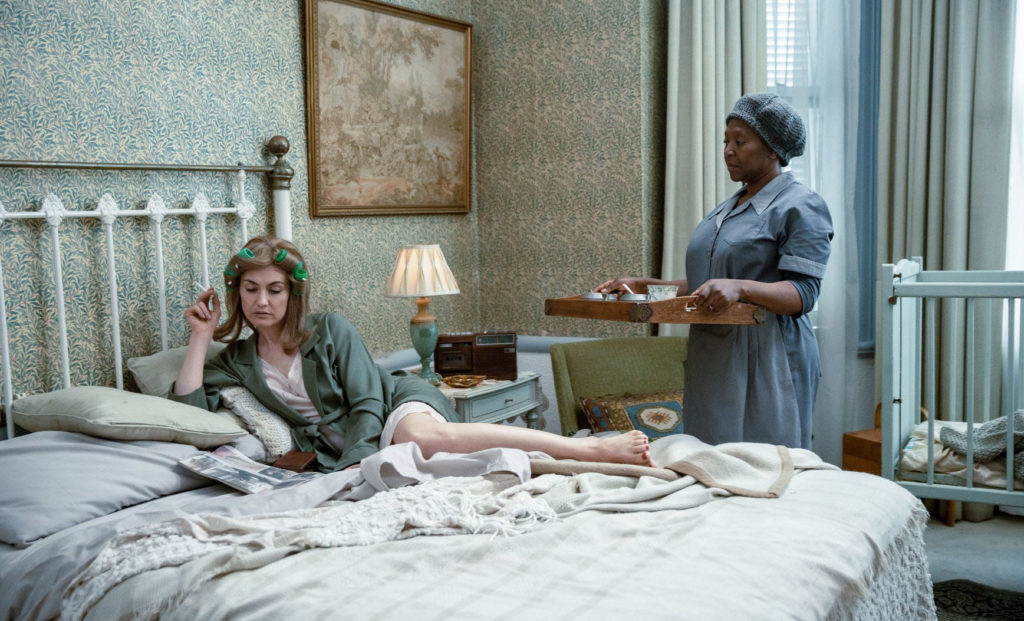On set: Behind the scenes of Christiaan Olwagen's take on the Poppie Nongena narrative where the protagonist (centre) is played by Clementine Mosimane. (Melanie Cleary)
Poppie Nongena tells the story of a black woman who tries to keep her family together under the apartheid pass law system that threatens to tear them apart. In 1980, novelist Elsa Joubert archived the story through her novel, The Long Journey of Poppie Nongena, after she encountered the black woman on whom she based the narrative. In 1982, the novel was adapted into an internationally acclaimed stage play by Joubert and late actress Sandra Kotzé. Almost four decades later, the Poppie Nongena story has once again landed in the hands of another white storyteller: Christiaan Olwagen, who recently released his cinematic adaptation: Poppie Nongena.
Olwagen is the Afrikaans director behind the remarkable war-period movie-cum-musical, Kanarie. The film tells the coming-of-age story of a queer Afrikaner boy who is conscripted by the South African Defence Force during the country’s state of emergency.
The action in Poppie Nongena takes place over seven days before Christmas. Under the Bantu Homeland Citizenship Act of 1970 Poppie receives deportation instructions that expect her to leave Cape Town by the end of the week. Even though she was raised, employed and brought up her children in the city, she is expected to make her way to the Ciskei, the homeland that has been allocated to her husband, who is in Cape Town as a migrant labourer.
During this time, the viewer watches the protagonist go through the daily cycle of begging, comforting, shrinking, praying and toiling, only to keep losing.
https://www.instagram.com/p/B8dgYR_g9Tp/?utm_source=ig_web_copy_link
To translate the protagonist’s desperation visually, Poppie Nongena is deliberate with its colour grading and framing. The film plays out in hushed greys and blues that make it seem as if the seven days the film takes place in are overcast. There’s a difference in the way that suburbia and the township are framed in the film. When Poppie is seen at her work place, the wide shots and minimal props give the impression of space and privacy. In contrast to this, scenes in the township where Poppie’s family lives are up close, cluttered and dense, a strategy that speaks to the ills of the spatial-planning and housing interventions put in place for townships.
 Inside the four room house that Poppie shares with her three children, husband and mother. Poppie Nongena’s ill husband (far left) is played by Chris Gxalaba (Melanie Cleary)
Inside the four room house that Poppie shares with her three children, husband and mother. Poppie Nongena’s ill husband (far left) is played by Chris Gxalaba (Melanie Cleary)
Together with the set and costume design, the colouring and framing make for a solid visual that is true to the times. None of the homes, offices, their decorations, the hairstyles or outfit changes look as if they were sourced almost four decades after the actual events. It’s in the crochet doilies and brass vases on tables, the antique tri-fold vanity mirror sets, the leather block heels, the berets, the oversized coats and petticoats.
This is with the exception of scenes depicting riots. The cinematography falls short in trying to make a cast and a handful of extras come across as a large group. Over and above this, the trouble with re-enacting such a scene is that — although the director does his best to choreograph its commotion — attempting to remake the very real pain that the student activists were living in presents a challenge.
Centring whiteness
For a film about Poppie working to keep her family together, Poppie Nongena centres its white characters. The opening credits lead into the home of a middle-class white family having their Sunday lunch. Thus, the first thing that we know about Poppie is that she is a maid who is about to be deported from the home she has built.
 The first thing that the film reveals about Poppie Nongena is how she’s a domestic worker who is about to be deported (Melanie Cleary)
The first thing that the film reveals about Poppie Nongena is how she’s a domestic worker who is about to be deported (Melanie Cleary)
By focusing on the seven days in which she has to leave Cape Town, Poppie Nongena’s framing of the protagonist robs her character of the dignity and empathy that comes with her nuanced back story.
In the novel The Long Journey of Poppie Nongena, Joubert details Poppie’s upbringing in a way that highlights the effects that colonisation, migration and religion have on the protagonist. The reader gets to imagine how these themes build Poppie’s character, leading to a clearer understanding of why she is determined to keep her entire family together — a narrative that is central to the plot. The intention to showcase how her determination centres on her family falls short in the film because, apart from the scene where they gather to pray, we only ever see Poppie interact with her family when there is conflict.
It’s possible that this portrayal is Olwagen’s attempt at showing viewers the effects of colonisation and apartheid on black folk — not only in the socioeconomic, spatial, spiritual and political restrictions that they were dealt, but also in how it shaped their perceptions of blackness. But even if that is the case, there’s a gap between the intention and the execution that messes with the viewer’s ability to grasp the film’s message.
https://www.instagram.com/p/B7oE7EUl036/?utm_source=ig_web_copy_link
Speaking about his vision for Poppie Nongena, Olwagen told Bizcommunity that the team knew trying to tell Poppie’s entire story through a film would prove to be difficult. “After meeting the novelist, Elsa Joubert, and getting her permission to take what we need and discard what we don’t, the screenwriter, Saartjie Botha, and I took a page from Virginia Woolf’s Mrs Dalloway — through the prism of a singular timespan, we can comprehend an entire lifetime,” said Olwagen.
Perhaps this disconnect comes from the lack of proximity that Olwagen has to the narrative.
It seems so, especially when Poppie Nongena is compared to Kanarie.
For Kanarie to happen, Olwagen joined forces with Charl-Johan Lingenfelder to co-write the film. The plot was inspired by Lingernfelder’s experiences of being in the military during apartheid. In addition to Lingenfelder’s personal accounts — about young boys who were displaced, Christianity being used as a weapon of military propaganda and queerness being silenced — Olwagen made use of photographic, theatrical and literary cues to create a quirky, magnetic screenplay in a manner that is sensitive to those people whose lived experiences the plot borrows from. The portrayal of the story continues to sit with me, two years after its premiere.
With the director and screenwriter deciding to pick and choose which part of Poppie’s narrative to include in the film, some of the scenes that they try to recreate land uncomfortably and leave the viewer uncertain about how they serve the plot.
Random scenes
Two such scenes are what seems to be an ubungoma initiation ceremony revolving around Poppie’s daughter and a wedding procession in the township where Poppie stays.
The scene depicting a spiritual ceremony sees women wearing idayimani headbands, white vests and umbhaco skirts praying and singing in a semicircle. The scene happens without any cues leading up to it. It’s not clear what the scene means because, after the dream, the trajectory of Poppie’s life doesn’t seem to change much. The wedding procession making its way through the township is not related to the lead or the film’s supporting cast. Although the wedding procession and initiation ceremony may be visual shorthands to suggest that black people lived full, loving, spiritual lives in spite of the oppressive cards they were dealt, their placement feels random.
By the time the film’s closing credits start to flash across the screen, I am reduced to a ball of despondency. Apart from demonstrating the plight of a black woman for the sake of making a film about black pain, I’m not sure what purpose Olwagen’s Poppie Nongena will truly fulfill for those who watch it.